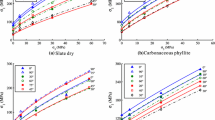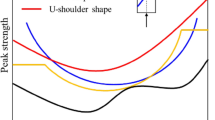Abstract
A modified empirical criterion is proposed to determine the strength of transversely anisotropic rocks. In this regard, mechanical properties of intact anisotropic slate obtained from three different districts of Iran were taken into consideration. Afterward, triaxial rock strength criterion introduced by Rafiai was modified for transversely anisotropic rocks. The criterion was modified by adding a new parameter \( \alpha \) for taking the influence of strength anisotropy into consideration. The results obtained have shown that the parameter \( \alpha \) can be considered as the strength reduction parameter due to rock anisotropy. The modified criterion was compared to the modified Hoek–Brown (Saroglou and Tsiambaos) and Ramamurthy criteria for different anisotropic rocks. It was concluded that the criterion proposed in this paper is a more accurate and precise criterion in predicting the strength of anisotropic rocks.









Similar content being viewed by others
References
Al-Ajmi AM, Zimmerman RW (2006) Stability analysis of vertical boreholes using the Mogi–Coulomb failure criterion. Int J Rock Mech Min Sci 43:1200–1211
Al-Harthi AA (1998) Effect of planar structures on the anisotropy of Ranyah sandstone, Saudi Arabia. Eng Geol 50:49–57
Allirote D, Boehler JP (1970) Evaluation of mechanical properties of a stratified rock under confining pressure. In: Proceedings of the Fourth Congress on ISRM, Montreux 1:15–22
Amadei B (1996) Importance of anisotropy when estimation and measuring in situ stresses in rock. Int J Rock Mech Min Sci Geo Abs 33(3):293–326
Amadei B, Savage WZ (1989) Anisotropic nature of jointed rock mass strength. J Eng Mech Div ASCE 115(3):525–542
Attewell P, Sandford M (1974) Intrinsic shear strength of a brittle, anisotropic rock—I. Experimental and mechanical interpretation. Int J Rock Mech Min Sci Geomech Abstr 11:423–430
Barla G, Goffi L (1974) Direct tensile testing of anisotropic rocks, In: Proceedings of the 3rd Congress of the International Society for Rock Mechanics, Denver, Colorado, USA, 1974, vol II, Part A, National Academy of Sciences, Washington DC, pp 93–98
Barla G, Innaurato N (1973) Indirect tensile testing of anisotropic rocks. Rock Mech 5:215–230
Chen CS, Hsu SC (2001) Measurement of indirect tensile strength of anisotropic rocks by the ring test. Rock Mech Rock Eng 34(4):293–321
Colak K, Unlu T (2004) Effect of transverse anisotropy on the Hoek–Brown strength parameter ‘m i ’ for intact rocks. Int J Rock Mech Min Sci 41:1045–1052
Darvishzadeh A (1991) Geology of Iran, 3rd edn, Tehran (In Farsi)
Donath FA (1961) Experimental study of shear failure in anisotropic rock. Geol Soc Am Bull 72:985–990
Donath FA (1964) Strength variation and deformational behavior in anisotropic rock. In: Judd WR (ed) State of stress in the Earth’s crust. Elsevier, New York, pp 281–298
Elmo D, Stead D (2010) An Integrated numerical modelling–discrete fracture network approach applied to the characterization of rock mass strength of naturally fractured pillars. Rock Mech Rock Eng 43:3–19
Hoek E (1964) Fracture of anisotropic rock. J S Afr Inst Min Metall 64:501–518
Hoek E (1990) Estimating Mohr–Coulomb friction and cohesion values from the Hoek–Brown failure criterion. Int J Rock Mech Min Sci 27:227–229
Hoek E, Brown ET (1980) Underground excavations in rock. Institution of mining and metallurgy, London
Horino FG, Ellickson ML (1970) A method of estimating strength of rock containing planes of weakness. Report of investigation 7449, US Bureau of Mines
Hudson JA, Harrison JP (2000) Engineering rock mechanics: An introduction to the principals, vol 1. Elsevier, London, pp 163–172
ISRM (2007) The complete ISRM suggested methods for rock characterization, testing and monitoring: 1974–2006. In: Ulusay R, Hudson JA (eds) Suggested methods prepared by the commission on testing methods, International Society for Rock Mechanics, Compilation Arranged by the ISRM Turkish National Group, Ankara, Turkey
Jaeger JC (1960) Shear failure of anisotropic rock. Geol Mag 97:65–72
Jaeger JC, Cook NGW, Zimmerman RW (2007) Fundamentals of rock mechanics, 4th edn. Blackwell publishing, London
Karakul H, Ulusay R, Isik NS (2010) Empirical models and numerical analysis for assessing strength anisotropy based on block punch index and uniaxial compression tests. Int J Rock Mech Min Sci 47(4):657–665
Kwasniewski M (1993) Mechanical behavior of anisotropic rocks. In: Hudson JA (ed) Comprehensive rock engineering, vol 1. Pergamon, Oxford, pp 285–312
Lo TW, Coyner KB, Toksoz MN (1986) Experimental determination of elastic anisotropy of Berea Sandstone, Chicopee shale, and Chelmsford granite. Geophysics 51:164–171
Matlab software (2009) The language of technical computing. The Mathwork Inc.
McLamore R, Gray KE (1967) The mechanical behavior of anisotropic sedimentary rocks. Trans Am Soc Mech Eng Ser B 89:62–76
Nasseri MH, Rao KS, Ramamurthy T (1996) Engineering geological and geotechnical responses of schistose rocks from dam project areas in India. Eng Geol 44:183–201
Nasseri MH, Rao KS, Ramamurthy T (1997) Failure mechanism in schistose rocks. Int J Rock Mech Min Sci 34(3–4):219
Nasseri MH, Rao KS, Ramamurthy T (2003) Anisotropic strength and deformational behavior of Himalayan schists. Int J Rock Mech Min Sci 40:3–23
Nova R (1980) The failure of transversely isotropic rocks in triaxial compression. Int J Rock Mech Min Sci 17:325–332
Paterson MS, Wong TF (2005) Experimental rock deformation—the brittle field. Springer, Berlin Heidelberg
Pomeroy CD, Hobbs DW, Mahmoud A (1971) The effect of weakness plane orientation on the fracture of Barnsley hard coal by triaxial compression. Int J Rock Mech Min Sci 8:227–238
Rafiai H (2011) New empirical polyaxial criterion for rock strength. Int J Rock Mech Min Sci 48:922–931
Ramamurthy T (1993) Strength, modulus responses of anisotropic rocks. In: Hudson JA (ed) Compressive rock engineering, vol 1. Oxford, Pergamon, pp 313–29
Ramamurthy T, Rao GV, Singh J (1988) A strength criterion for anisotropic rocks. In: Proceedings of the Fifth Australia–New zealand Conference on Geomechanics, vol 1. Sydney, pp 253–257
Ramamurthy T, Venkatappa RG, Singh J (1993) Engineering behaviour of phyllites. Eng Geol 33:209–225
Rao KS, Rao GV, Ramamurthy T (1986) A strength criterion for anisotropic rocks. Ind Geotech J 16(4):317–333
Saroglou H, Tsiambaos G (2008) A modified Hoek–Brown failure criterion for anisotropic intact rock. Int J Rock Mech Min Sci 45:223–234
Saroglou H, Marinos P, Tsiambaos G (2004) The anisotropic nature of selected metamorphic rocks from Greece. J S Afr Inst Min Metall 104(4):215–222
Seyedi SJ (2005) Determination of geomechanical properties of slate and its effect on stability of Zhave dam water tunnel. MSc. Thesis, Tarbiat Modares University, Tehran
Singh M, Rao KS, Ramamurthy T (2002) Strength and deformational behavior of a jointed rock mass. Rock Mech Rock Eng 35(1):45–64
Taleghani AM (2002) Geomorphology of Iran, first publication, Tehran (In Farsi)
Wardle LJ, Gerrard CM (1972) The equivalent anisotropic properties of layered rock and soil masses. Rock Mech Rock Eng 4(3):155–175
Author information
Authors and Affiliations
Corresponding author
Rights and permissions
About this article
Cite this article
Saeidi, O., Vaneghi, R.G., Rasouli, V. et al. A modified empirical criterion for strength of transversely anisotropic rocks with metamorphic origin. Bull Eng Geol Environ 72, 257–269 (2013). https://doi.org/10.1007/s10064-013-0472-9
Received:
Accepted:
Published:
Issue Date:
DOI: https://doi.org/10.1007/s10064-013-0472-9




